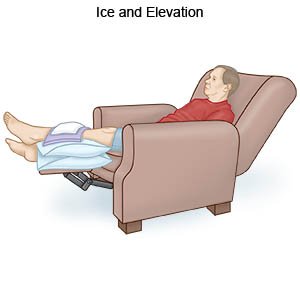Swollen Ankle Joint
Medically reviewed by Drugs.com. Last updated on Aug 4, 2025.
What do I need to know about a swollen ankle joint?
A swollen ankle joint may be caused by conditions such as arthritis or gout, or by an injury. You may have other symptoms such as pain and trouble moving or putting weight on your ankle.
How is the cause of a swollen ankle joint diagnosed?
Your healthcare provider will ask about your symptoms and any medical conditions you have. He or she will also ask if you have had any recent injuries. He or she will examine your ankle and check how well it moves in different directions. Blood tests or x-rays may be used to help find the cause of the swelling. Fluid may be removed from your ankle joint and sent to a lab for tests.
How is a swollen ankle joint treated?
Treatment depends on the cause of your swollen ankle joint. Your healthcare provider may recommend any of the following:
- Rest your ankle. Avoid activities that make the swelling or pain worse. You may need to avoid putting weight on your ankle while you have pain. Crutches or a walker can be used to avoid putting weight on your ankle.
- Apply ice on your ankle for 15 to 20 minutes every hour or as directed. Use an ice pack, or put crushed ice in a plastic bag. Cover it with a towel. Ice helps prevent tissue damage and decreases swelling and pain.

- Compress your ankle with a brace or bandage to help reduce swelling. Use a brace or bandage only as directed.
- Elevate your ankle above the level of your heart as often as you can. This will help decrease swelling and pain. Prop your joint on pillows or blankets to keep it elevated comfortably.
- Apply heat on your ankle for 20 to 30 minutes every 2 hours for as many days as directed. Heat helps decrease pain.
- NSAIDs , such as ibuprofen, help decrease swelling, pain, and fever. This medicine is available with or without a doctor's order. NSAIDs can cause stomach bleeding or kidney problems in certain people. If you take blood thinner medicine, always ask your healthcare provider if NSAIDs are safe for you. Always read the medicine label and follow directions.
- Physical therapy may be recommended. A physical therapist teaches you exercises to help improve movement and strength, and to decrease pain.
When should I seek immediate care?
- You cannot move your ankle at all.
- You have severe pain that does not get better with pain medicine.
When should I call my doctor?
- You have a fever.
- You have redness or warmth over your ankle.
- The swelling does not go down with treatment.
- You have questions or concerns about your condition or care.
Care Agreement
You have the right to help plan your care. Learn about your health condition and how it may be treated. Discuss treatment options with your healthcare providers to decide what care you want to receive. You always have the right to refuse treatment. The above information is an educational aid only. It is not intended as medical advice for individual conditions or treatments. Talk to your doctor, nurse or pharmacist before following any medical regimen to see if it is safe and effective for you.© Copyright Merative 2025 Information is for End User's use only and may not be sold, redistributed or otherwise used for commercial purposes.
Learn more about Swollen Ankle Joint
Treatment options
Care guides
Further information
Always consult your healthcare provider to ensure the information displayed on this page applies to your personal circumstances.
